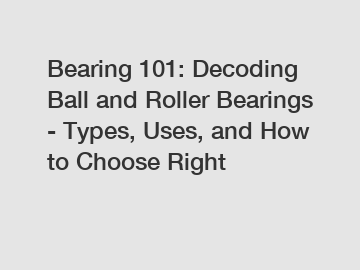Bearing 101: Decoding Ball and Roller Bearings - Types, Uses, and How to Choose Right
Welcome to the world of bearings, where these ingenious mechanical components facilitate smooth and efficient motion across various industries. From everyday household appliances to complex machinery in manufacturing, bearings play a pivotal role in ensuring seamless operations. In this blog, we will delve into the fundamentals of ball and roller bearings, explore their different types, understand their applications, and learn how to choose the right one for your unique requirements.
Understanding Bearings:
Bearings can be best described as small, precision-engineered devices that reduce friction between moving parts within a machine or system. By enabling smooth rotation or linear motion, bearings help transfer loads and minimize energy loss, ensuring longevity and reliability of the machinery they are incorporated into.

Types of Bearings:
1. Ball Bearings:
Ball bearings, as the name suggests, are composed of a set of balls situated within an inner and outer ring. These balls, typically made of steel or ceramic, roll between the rings to facilitate motion. Here are some common types of ball bearings:
a) Deep Groove Ball Bearings: Suitable for high-speed applications and radial loads, these bearings are often found in automobiles, electric motors, and appliances.
b) Angular Contact Ball Bearings: Designed to withstand both radial and axial loads, these bearings excel in applications where thrust or combined loads are encountered, such as machine tools and automotive suspensions.
c) Thrust Ball Bearings: Specifically engineered to handle axial loads, thrust bearings are commonly employed in automotive and industrial machinery, like gearboxes and steering systems.
2. Roller Bearings:
Unlike ball bearings, roller bearings utilize cylindrical or tapered rolling elements instead of spherical balls. These components distribute the load over a larger area, making them ideal for heavy-duty applications. Here are a few types of roller bearings:
a) Cylindrical Roller Bearings: With high radial load-carrying capacity and excellent resistance to shock and vibration, cylindrical bearings are often used in heavy machinery like wind turbines, construction equipment, and power generation plants.
b) Tapered Roller Bearings: Ideal for handling radial and axial loads simultaneously, tapered bearings are commonly found in automotive wheel hubs, gearboxes, and large conveyor systems.
c) Spherical Roller Bearings: Perfect for applications with misalignment or shaft deflection, these bearings accommodate large radial loads while maintaining high-speed operation. Industries such as mining, paper, and steel rely on spherical roller bearings.
Choosing the Right Bearing:
Selecting the appropriate bearing for your specific application is crucial to ensure optimal performance, longevity, and cost-effectiveness. Here are some factors to consider when making your selection:
1. Load Requirements: Determine the type of load (radial, axial, or a combination of both) your bearing needs to support. It's vital to accurately calculate the magnitude and direction of the load to prevent premature failure.
2. Speed: Consider the rotational speed and acceleration of your machinery. Bearings are designed for different maximum operating speeds, and exceeding these limits can lead to overheating and failure.
3. Environmental Factors: Assess the operating conditions, including temperature, humidity, and exposure to contaminants like dust or moisture. Choosing bearings with suitable materials and seals ensures their longevity in challenging environments.
4. Lubrication: Adequate lubrication is essential for bearing performance. Evaluate the lubrication requirements of your specific bearing type and application to prevent wear, reduce friction, and dissipate heat effectively.
5. Space Constraints: Consider the available space and dimensional requirements. Some applications require compact yet efficient solutions, while others can accommodate larger bearings.
Conclusion:
As we've discovered, bearings are indispensable components that enable smooth motion and reduce friction in a wide range of industries. Understanding the different types of ball and roller bearings, their applications, and the factors to consider when selecting the right one is crucial for ensuring the longevity and efficiency of your machinery.
Whether it's the precise movements of an industrial robot or the smooth rotation of an automotive wheel, the right bearing choice can make all the difference. So, before embarking on your next machinery project, take the time to decode ball and roller bearings, and choose the perfect bearing solution for optimal performance and reliability.
For more deep groove ball bearing advantages, what is a cross shaft, 62tb0629b29information, please contact us. We will provide professional answers.


